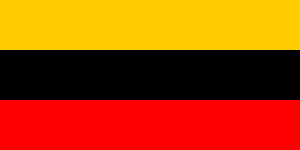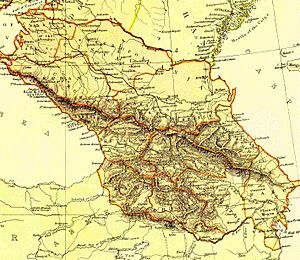Transcaucasian Democratic Federative Republic facts for kids
The Transcaucasian Democratic Federative Republic (TDFR) was a country that existed for a very short time in the South Caucasus region. This area is located where Europe and Asia meet. Today, this land is part of the countries Armenia, Azerbaijan, and Georgia. The TDFR was also known as the Transcaucasian Federation. It was formed after the Russian Empire collapsed, but it didn't last long because of different ideas among its leaders.
Contents
What Was the Transcaucasian Federation?
The Transcaucasian Democratic Federative Republic was a new country created in April 1918. It brought together three main groups of people: Armenians, Azerbaijanis, and Georgians. They all lived in the South Caucasus region. This new country was formed during a time of big changes, right after the Russian Revolution and the end of World War I.
Why Was It Formed?
For a long time, the South Caucasus was part of the Russian Empire. But in 1917, the Russian Empire fell apart. This left the region without a clear government. Leaders from Armenia, Azerbaijan, and Georgia decided to work together. They wanted to create their own independent country. They hoped this would bring peace and stability to the region.
The Role of the Seim
The main governing body of the TDFR was called the Seim. It was like a parliament, where representatives from the different groups met. Nikolay Chkheidze was the Chairman of the Seim. The Seim tried to make decisions for everyone. However, it was hard because the different groups had their own goals and ideas for the future.
Challenges and Disagreements
Even though they formed a country, the leaders faced many problems. They disagreed on important issues like land, borders, and how to deal with other countries. The biggest challenge was deciding if they should stay together or become separate nations.
Different Views Among Leaders
- Georgians often wanted to form their own independent country. They felt their culture and language were unique.
- Armenians were worried about their safety, especially with ongoing conflicts in the region. They also wanted their own state.
- Azerbaijanis had their own ideas about their future, often looking towards closer ties with other Turkic-speaking peoples.
These different goals made it very difficult for the TDFR to work as one country.
The End of the Federation
The Transcaucasian Democratic Federative Republic lasted only about five weeks. The disagreements among the leaders became too strong. They could not agree on a common path forward.
Declaration of Independence
On May 26, 1918, the Seim met for the last time. Irakli Tsereteli gave a speech, explaining that the federation could not continue. The leaders decided it was best for each group to form its own independent country.
New Countries Emerge
- On May 26, 1918, Georgia declared its independence, forming the Democratic Republic of Georgia.
- On May 28, 1918, Azerbaijan declared its independence, forming the Azerbaijan Democratic Republic.
- Also on May 28, 1918, Armenia declared its independence, forming the First Republic of Armenia.
This marked the end of the Transcaucasian Democratic Federative Republic. Even though it was short-lived, it was an important step for these nations to gain their independence.
Images for kids
See also
 In Spanish: República Democrática Federal de Transcaucasia para niños
In Spanish: República Democrática Federal de Transcaucasia para niños






